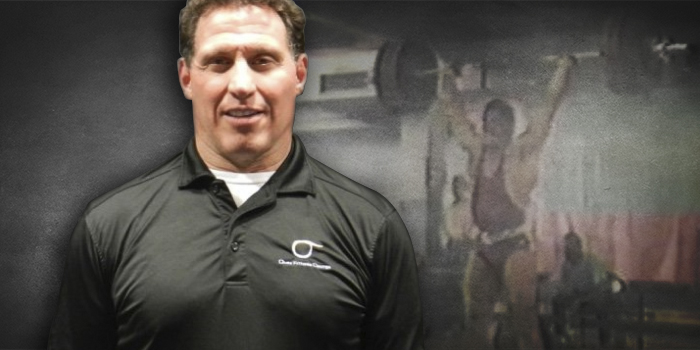
Joe Gazio passed away from a recurrence of pancreatic cancer on November 30, 2017. Joe, 58, had been a five-time Empire State Weightlifting Champion, a Metropolitan and New York State Champion and record holder, Master of Sport, and Level 1 USAW coach. Joe’s best lifts were a 145-kilogram snatch and 175-kilogram clean and jerk. His lifting career spanned the 1980’s into the late 1990’s and was just reaching his prime as a coach at the time of his demise.
Joe was as familiar with the Soviet training method as anyone outside of the USSR could be. Starting in 1979, Joe was coached by Naum Kelmansky, a former member of the Soviet Union’s weightlifting team, and later a coach at the Soviet Sports Institute in Kiev, Ukraine. Joe and Naum became as close as father and son. When I met Joe at Queens, New York's Lost Battalion Hall (LBH) in 1984, Joe was also assisted by former Soviet team weightlifter Arnold Khalfin and Mischa Kamen, coach of the great Anatoli Pisarenko. Joe’s coaches knew the Russian system for the good and simple reason that they created it.
Through Coach Kelmansky, Joe was invited to spend two weeks in Kiev last summer and had been invited to return in 2018. He was delighted to find that his coach is still venerated in the former Soviet republic. I encouraged Joe to contact Louie Simmons, as they share a common interest in this methodology. After a two-hour phone call, Louie emailed Joe, “Your coaches have forgotten more about strength than I will ever know.” As a tribute to Joe and his coaches, I’d like to share his knowledge of the Soviet training system.
In a word, the Soviet system was predicated upon tonnage. Their total volume was enormous. As an example, Coach Kelmansky’s warm-up was to perform a power snatch with an empty bar, into a press behind neck, into an overhead squat, for 10 sets of 20 repetitions. Then the workout began.
They trained twice daily, three hours in the morning and two more in the evening, six days weekly. Tonnage was calculated in the classical lifts beginning at 60% of maximum. Each workout was 20 to 30 metric tons. Workouts always varied but generally followed a heavy/light/medium rotation. 12-week training cycles were concluded with a competition. Training intensities in the 70% to 90% zone comprised 80% of the annual workload, with 10% annually below 70%, and the final 10% above 90% intensity.
RECENT: Strength 101 from Westside Barbell
Assistance work was voluminous, with many squat, pull, and press variations. Typical set and repetition schemes for assistance work were four sets of eight reps, six sets of six, five sets of five, and six or eight sets of three. They rested three to five minutes between sets. Lunges were performed to train the small muscles not worked by squats. Plyometric jumps were performed over staggered rows of chairs. Back raises concluded each session. Once every 10 weeks, Coach Kelmansky had Joe finish the evening session with 10 sets of 10 in the back squat at 60%, to master the weight.
I found it interesting that the Soviet Union had their weightlifters perform bench presses and curls once a week, to present an athletic appearance on the platform. Like many weightlifters, Joe had no great love for the bench press but still lifted over 400 pounds in nothing but a t-shirt. He deadlifted 750 pounds wearing straps and squatted 300 kilograms in the Olympic style. Roberto Urrutia was one of many world-class visitors to LBH to be impressed with Joe’s strength. In fact, Coach Kelmansky chided Joe for not lifting more in the classical lifts, insisting that any weight which can be pulled to waist height should be cleaned, and Joe could high pull 182.5 kilograms.
In the Soviet Union, sportsmen trained at different gyms by their classification. If a lifter stopped progressing, he wasn’t thrown out of the program, so much as he saw that he was still training the same gym, and eventually took the hint. Coach Kelmansky told me that if a sportsman showed up at the gym and declared that he didn’t feel like lifting that day, he was told, “Very well. Enjoy Siberia.” Coach Kelmansky was not smiling when he told me this.
When Bulgarian superheavyweight Antonio Krastev relocated to New York, he trained at Lost Battalion Hall, and he and Joe were roommates for a year and a half. Krastev related that the Bulgarians outperformed the Soviets in the lighter weight classes, but that the Soviets were much stronger athletes, stating, “The Russians were animals.” He also noted that no one performed Coach Ivan Abadjiev’s methodology until they had spent years developing a foundation by training the Soviet method.
At the time of his death, Joe was a partner in Omni Fitness in Uniondale, New York. CrossFit’s popularity made Joe a highly sought weightlifting coach at area CrossFit gyms. Joe loved helping serious athletes of all skill levels and was extremely generous with his time. He felt that USA weightlifting wasn’t availing itself of coaches Kamen, Kelmansky, and Khalfin. Relating to you what I learned from Joe Gazio is my tribute to the man and his coaches.
Dave Kirschen has identified Howard Menkes as the Chuck Norris on the elitefts website. Howard once celebrated Evel Knievel's birthday by pulling an 1160-pound anchor chain across a parking lot.










A lot of this article confirmed a lot of the stories he would tell me. It was nice to read. I know he had a daughter. If she reads this, I'm sorry for your loss. He was a great guy and friend and an expert weightlifting coach that passed on a wealth of knowledge to me that I use all the time to teach others now that weightlifting is popular again due to cross fit.
RIP joe.
CT